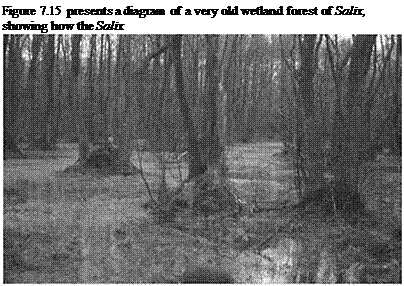Much vegetation establishment focuses on the need for ideal conditions of good fertile soil. Maybe it is time to reflect deeper with regard to the dominating soil-water conditions and their consequences for design in different cities or for reaching an attractive, multi-functional landscape, rich in contrast, variety and identity. Maybe we could gain a lot if, rather than trying to force the vegetation into a narrow ‘good, medium soil-water situation’, we instead try to use the whole spectrum, from the extremes of dry and nutrient-rich to wet and nutrient-poor. If we focus particularly on woodland types, then these are found along the whole gradient, and their use will result in very different characters when compared to each other. This stresses the importance of not searching for ideal types that just belong to the rich soils but rather
|
|
7.12
Aachen. Open woodland planting that is suggestive of the sparse vegetation patterns of extreme conditions
those that belong to the more acid soils, if we consider the ‘normal’ city situation. Many seminatural vegetations with a strong and attractive character are actually found in extreme situations, which might make us consider what we can gain by a complementary approach, in which we utilise the normal ‘good’ conditions to create robust vegetation and to create very special places by utilising the extremes.
Figure 7.11 shows a private garden in Dalby Sweden, with acid, open-grown woodland with birches, pruned spruces (a Swedish type of bonsai), blueberries, heather and mini-mires with mosses, created in a region in which very few would expect such a landscape, though it could be said to be more typical for other Scandinavian regions. The garden is supplemented with many plants belonging to the present biotope types but coming from other parts of the world. It is a garden area with many names: the secret garden, the moss garden, the blue berries garden and the Mattis garden.
The photograph in Figure 7.12 is from Aachen on the border between Germany and the Netherlands. Sides of concrete, a floor of gravel and an open planting with trees belonging to this extreme habitat creates a strong character. This can be compared with similar situations, for example in which a pedestrian walkway passes under a motorway, and concrete is used in a conventional way to form a functional tunnel.
Figures 7.13 to 7.15 show how wetland forests are used, or could be used, as inspiration in a design. Wetland forests are said to belong to the most species-rich habitats (Figure 7.13). As such, they can offer extremely rich experiences of landscape. Increasing interest in environmental solutions to urban drainage will give us more possibilities in the future to explore fields within designs that have so far been hardly touched.
 |
7.13
An ancient wetland forest of alder
 |
7.14
Designed wetland forest in the new housing area of Vastra Hamnen in Malmo, Sweden—the national
exhibition of experimental houses and green surroundings in 2001
|
|
7.15
Very old wetland forest of Salix (from the PhD thesis by Gustavsson (1986)) showing how the willow species form self-regenerating woodland
species, through an ‘intelligent strategy’, are able to spread step by step, making it difficult for other species to evolve. When the outer branches get older they sink due to the weight, and some go under the water and come in contact with mud or other kinds of substrates, thereby giving a chance to new roots. A new individual is therefore formed and the old links become rotten within a few years.





